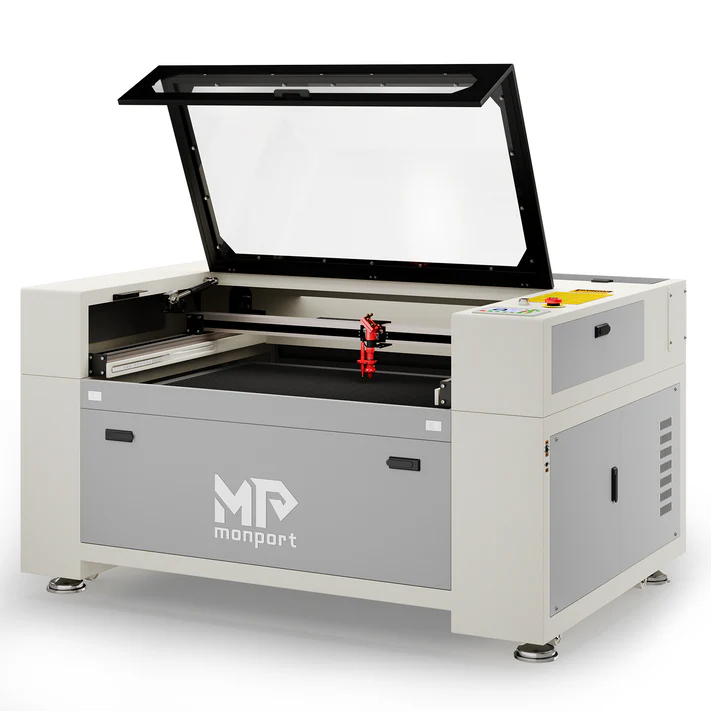Laser cutter machines have become an indispensable tool across various industries, known for their unparalleled precision, speed, and versatility. Whether you’re a manufacturer, a designer, or a hobbyist, understanding the intricacies of laser cutters can significantly enhance your productivity and the quality of your work. In this comprehensive guide, we delve into everything you need to know about laser engraving—from the basics to advanced techniques, and tips for selecting the right machine for your needs.
Understanding Laser Cutter Machines
What is a Laser Cutter Machine?
A laser cutter machine uses a focused laser beam to cut or engrave materials with extreme precision. The technology behind these machines allows for the cutting of complex shapes and patterns with minimal material waste. The laser beam is controlled by a computer, which follows a digital design to execute the cuts with exact accuracy.
Types of Laser Cutter Machines
-
CO2 Laser Cutters
CO2 laser cutters are the most commonly used type of laser cutter machines. They are ideal for cutting and engraving non-metallic materials such as wood, acrylic, plastic, glass, and fabric. The CO2 laser is created by electrically stimulating a mixture of carbon dioxide, nitrogen, hydrogen, and helium gases.
-
Fiber Laser Cutters
Fiber laser cutters are primarily used for cutting metals such as stainless steel, aluminum, and copper. These machines use a solid-state laser source, which is created by doping a fiber of glass with rare earth elements. Fiber lasers are known for their efficiency, high power, and the ability to cut through thick materials with ease.
-
Nd
Laser Cutters
Neodymium-doped Yttrium Aluminum Garnet (Nd
) lasers are a type of solid-state laser cutter. They are versatile and can be used for both cutting and welding metals and some plastics. Nd
lasers are often used in industries that require precision welding and engraving.
How Do Laser Cutter Machines Work?
The laser cutter machine works by directing a high-powered laser beam onto the surface of the material to be cut. The intense heat generated by the laser causes the material to melt, burn, or vaporize, creating a clean and precise cut. The process is controlled by a computer that follows a pre-designed pattern or blueprint, ensuring consistent results every time.
Advantages of Using Laser Cutter Machines
-
High Precision and Accuracy
Laser cutter machines offer unparalleled precision, allowing for the cutting of intricate designs with a high level of accuracy. This precision is crucial in industries where tight tolerances are required.
-
Versatility
One of the key advantages of laser cutters is their versatility. They can cut and engrave a wide range of materials, including metals, plastics, wood, glass, and textiles. This makes them suitable for various applications across different industries.
-
Efficiency and Speed
Laser cutter machines operate at high speeds, making them ideal for large-scale production runs. The automated nature of these machines reduces the need for manual intervention, increasing productivity and efficiency.
-
Minimal Material Waste
The precision of laser cutting reduces material waste, as the laser cuts along narrow paths with minimal kerf (material removed by the cutting process). This not only saves materials but also reduces the overall cost of production.
-
Cost-Effective
While the initial investment in a laser cutter machine can be significant, the long-term benefits, such as reduced material waste, increased efficiency, and lower labor costs, make it a cost-effective solution for many businesses.
Applications of Laser Cutter Machines
-
Manufacturing
In the manufacturing industry, laser cutter machines are used to produce parts and components with high precision. They are particularly valuable in industries such as automotive, aerospace, and electronics, where precision and consistency are critical.
-
Signage and Advertising
Laser cutters are widely used in the signage and advertising industry for creating intricate designs, logos, and letters on various materials. The ability to produce detailed and customized designs makes laser cutters a preferred choice for businesses in this sector.
-
Jewelry Making
The jewelry industry benefits from laser cutters due to their ability to cut and engrave precious metals with fine details. Laser cutting allows for the creation of complex designs that would be difficult to achieve with traditional methods.
-
Fashion and Textiles
In the fashion and textile industry, laser cutters are used to cut fabrics with precision, enabling the creation of intricate patterns and designs. The speed and accuracy of laser cutting also make it ideal for mass production of garments and accessories.
-
Prototyping and Customization
Laser cutter machines are invaluable in the prototyping process, allowing designers and engineers to quickly produce and test their designs. Additionally, the ability to customize products with laser engraving makes these machines popular in various creative industries.
Choosing the Right Laser Cutter Machine
-
Consider the Material You Will Be Cutting
The type of material you plan to cut will determine the type of laser cutter machine you need. For instance, if you primarily work with metals, a fiber laser cutter would be the best choice. On the other hand, if you work with non-metallic materials, a CO2 laser cutter would be more suitable.
-
Power and Speed
The power of the laser cutter machine is an important factor to consider, especially if you will be cutting thick or dense materials. Higher power lasers can cut through thicker materials more easily. Additionally, the speed of the machine is crucial for efficiency, especially in high-volume production environments.
-
Size of the Work Area
The size of the machine’s work area should match the size of the materials you plan to cut. If you work with large sheets of material, you will need a machine with a larger work area. However, if you work with smaller pieces, a machine with a smaller work area may be sufficient.
-
Budget
Laser cutter machines vary widely in price, depending on their type, power, and features. It’s important to consider your budget and choose a machine that offers the best value for your money. Keep in mind that while higher-end machines may have a higher upfront cost, they often offer better performance and durability.
-
Software Compatibility
The software that controls the laser cutter machine is an essential consideration. Ensure that the machine is compatible with the design software you use and that the software is user-friendly and capable of handling the complexity of your designs.
Maintenance and Safety Tips for Laser Cutter Machines
-
Regular Maintenance
Regular maintenance is crucial to keep your laser cutter machine in optimal condition. This includes cleaning the lenses, checking the alignment of the laser beam, and ensuring that the cooling system is functioning properly. Regular maintenance not only extends the life of your machine but also ensures consistent cutting quality.
-
Safety Precautions
Safety is paramount when operating a laser cutter machine. Always wear appropriate safety gear, such as protective eyewear, and ensure that the machine is used in a well-ventilated area. Additionally, it’s important to follow the manufacturer’s safety guidelines and to have a fire extinguisher on hand in case of emergencies.
-
Material Handling
Certain materials, such as PVC, can release toxic fumes when cut with a laser. It’s important to know the properties of the materials you are cutting and to ensure that your machine is equipped with the necessary ventilation and filtration systems to handle these materials safely.
Conclusion
Laser cutter machines offer incredible versatility, precision, and efficiency, making them a valuable asset across various industries. By understanding the different types of laser cutters, their applications, and how to choose the right machine for your needs, you can unlock the full potential of this powerful technology. Whether you’re in manufacturing, design, or any other field that requires precise cutting and engraving, investing in a laser cutter machine can significantly enhance your capabilities and productivity.




